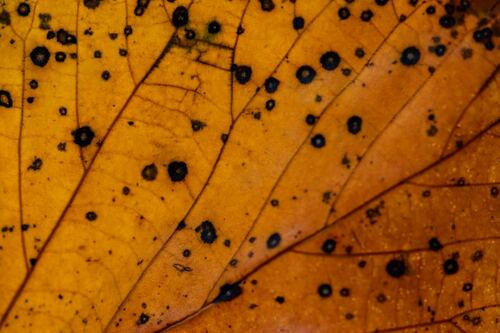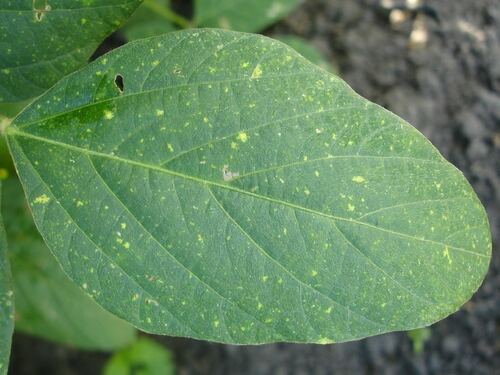The Impact of Foliar Fungus
Introduction
Foliar fungi are a group of fungi that infect the leaves of plants. This leads to many kinds of diseases that affect a wide range of plants like farm crops, decorative plants, and trees. The effects of foliar fungi can be harsh, with results such as a lower number of crops as well as less-healthy crops to harvest. They can also damage decorative plants and trees.
Types of Foliar Fungus
There are many kinds of foliar fungi that can infect plants and cause diseases such as powdery mildew, downy mildew, leaf spot diseases, rust fungi, blight diseases, and scab diseases. Here are some examples below:
ANTHRACNOSE

Pear Tree Leaves with Fungal Spots – Image by Hans from Pixabay
Anthracnose is a group of fungal diseases that can severely harm many kinds of plants. It can show up as lesions or spots on leaves, which can range in color from yellow to brown or black. These spots can get larger and darker as the infection progresses. Anthracnose mainly affects young leaves and twigs, which can lead to trees losing their leaves.
Ideal Conditions:
- Anthracnose thrives in humid environments and can spread through rain, wind, and water sources.
Control/Prevention:
- You can keep your tree healthy by pruning it , giving it the right amount of water, and removing any infected parts of the tree. This will make sure the leaves aren’t overcrowded and keep the tree healthy and strong.
- Fungicides can also help slow the spread of the disease. Copper-based fungicides should be used carefully, however. This is because the copper can gather in the soil and affect creatures such as earthworms.
BOTRYOSPHAERIA
Botryosphaeria is a fungal disease that mainly affects trees. It can cause sores to grow on the tree and even cause part of the tree to wilt.
Symptoms:
- This disease can cause wilting or dieback of branches in otherwise healthy-looking trees or shrubs. Cankered twigs and branches may go unnoticed until they start to wilt. Beneath the bark, the wood will be discolored brown to reddish brown instead of white.
Control/Prevention:
- There are no fungicides that can control this disease. Instead, the best way to prevent infection is to make sure your plants are in optimal health so they can fight this disease.
FIRE BLIGHT

Early Signs of Fire Blight on a Fruit Tree
Fire blight mainly affects plants in the Rosaceae family, such as roses, strawberries, hawthorn, raspberries, and more. This disease spreads very quickly and can be very harmful.
Symptoms:
- New shoots and leaves appear glassy and water-soaked before turning brown or black. These shoots and leaves will also bend into a crook shape.
- Dry twigs and dead branches appear burnt, with dead leaves remaining on the tree.
- Reddish-brown streaks can appear in the sapwood beneath the bark.
- Dark, sunken cankers that appear water-soaked will appear.
- Bacterial ooze forms on fruit.
Spread:
- Fire blight can be spread by bringing in foreign plants or materials to breed plants that may have the disease. It can also be spread locally by wind, rain, insects, vehicles, people, and equipment.
SUDDEN OAK DEATH (SOD)
Sudden Oak Death is caused by a water mold called Phytophthora ramorum . This bacterium affects the leaves and twigs of many kinds of plants in forests and nurseries; however, Sudden Oak Death (SOD) mainly affects oak trees in California and Oregon.
Symptoms:
- Oak trees will die within a few weeks or months due to wilting of the stems as well as rapid browning of leaves.
- This disease is particularly lethal to coast live oaks as well as tan oaks.
Control/Prevention:
- The best way to prevent this disease is to avoid buying plants that can host and spread SOD, such as California bays and plants in the genus Rhododendron , which can spread the disease through their leaves.
How does Foliar Fungus Spread?

A Close-Up of Foliar Fungal Spots – Photo by Dids
Foliar fungi reproduce through spores , which are then spread by wind, rain, lack of air circulation, and more. The climate plays a big role in how it’s spread. Fungus is opportunistic—it will take any chance it gets to survive. A good analogy is how mold is created in your shower (lack of air circulation).
NEGATIVE IMPACTS
Foliar fungi can cause serious stress to plants. This can lead to reduced health because the plants will have a harder time photosynthesizing, or absorbing nutrients from the sun. While these fungi may not always cause extreme harm to trees, they can weaken plants. This makes them more likely to be infected by other diseases and also more susceptible other environmental stressors.
TREATMENTS
Foliar fungi can be managed through multiple different ways that aim to limit its spread and impact. The best way to fight these diseases is through healthy practices, chemical treatments, and in some cases, professional help. Here are some steps to control and prevent foliar fungi:
Cultural Practices
- Sanitation: Regularly rake and get rid of fallen leaves and plant debris that show signs of infection. This helps lower the number of spores available to infect healthy plants. Cleaning gardening tools after use can also prevent spreading fungi from one plant to another.
- Pruning: Prune infected leaves, branches, and twigs at least 4-6 inches below the visible signs of infection. Use clean, sterilized tools to avoid spreading the fungi. Regular pruning improves ventilation around the tree. This lowers humidity and creates an environment that makes it harder for fungi to grow.
- Water Management: Water plants at the base instead of at the leaves to keep them dry. Wet leaves provide a more favorable environment for fungal spores to grow and infect plants. Making sure your plants have proper drainage to prevent waterlogging can also prevent fungi from growing.
Chemical Treatments
- Fungicides: If you see any warning signs of infection, use fungicides . The earlier the better, because fungicides work better when used early in the disease cycle. You can also apply them beforehand to make sure your plant doesn’t get infected. Copper-based fungicides can also help, but they should be used carefully. This is because the copper can gather in the soil and affect important creatures like earthworms.
- Tree Trunk Injections: In severe cases, injections directly into the tree trunk itself can get fungicides into the plant’s vascular system. This provides better, more targeted protection. This is especially useful for large trees where sprays may not reach the infected parts.
- Foliar Sprays: Foliar sprays help in applying fungicides directly on the leaves. Make sure to spray the leaves completely for the best effectiveness. This should be done in the early morning or late in the evening so that you can avoid burning the leaves in direct sunlight.
Biological Controls
- Beneficial Microbes: Introduce good microbes that compete with or work against the fungi. Products that contain microbes such as Bacillus subtilis and Trichoderma species are good examples of this.
- Compost Teas: Compost “teas” can also bring good microorganisms to the plant. This can strengthen its natural defenses against the fungi.
Integrated Pest Management ( IPM )
- Monitoring: Regularly inspect plants for early signs of infection. Early detection is extremely important to treat it effectively. You can use sticky traps or other monitoring tools to track the presence and spread of fungal spores.
- Resistant Varieties: Certain plants are immune or tolerant to specific foliar fungi. Having these kinds of plants can greatly reduce the frequency and severity of disease.
- Crop Rotation and Diversification: By rotating the crops and varying the kinds of plants you grow, you can disrupt the life cycle of the foliar fungi. This works especially well in farm settings.
Professional Help
- Arborists: You can seek advice from a qualified arborist for accurate diagnosis and treatment options, especially for large or valuable trees. Arborists can give specialized treatments like trunk injections, deep root fertilization, and tailored pruning services.
- Extension Services: You can also make use of local extension services for advice on common fungal diseases in your area and recommendations on how to handle them.
Preventative Measures
- Mulching: Put mulch around the base of the plants to keep soil moisture and keep weeds from growing, reducing competition for nutrients and improving plant health.
- Soil Health: Keep soil healthy by properly fertilizing it. Healthy soil helps plants grow better and makes them less likely to be infected.
- Environmental Management: Make sure you give your plants enough space when planting. This makes sure they have good air circulation and reduces the humidity around them.
CONCLUSION

Early Signs of Foliar Fungal Disease – Image by Julio César García from Pixabay
Foliar fungi can cause a wide range of diseases that seriously affect the health of plants. To properly control them, you must identify them early and use proper practices. In some cases, use fungicides. By understanding foliar fungi, we can protect our plants and make sure they stay healthy and strong.
When you notice signs of fungal infection, you must act quickly to prevent spreading. If in doubt, contact Arborist Now . Our certified arborists can identify a myriad of tree diseases and help you find the best course of treatment. Aided by our expertise, you can keep your greenery fungus-free and healthy!
Main Photo Credit: agric.wa.gov.au.


